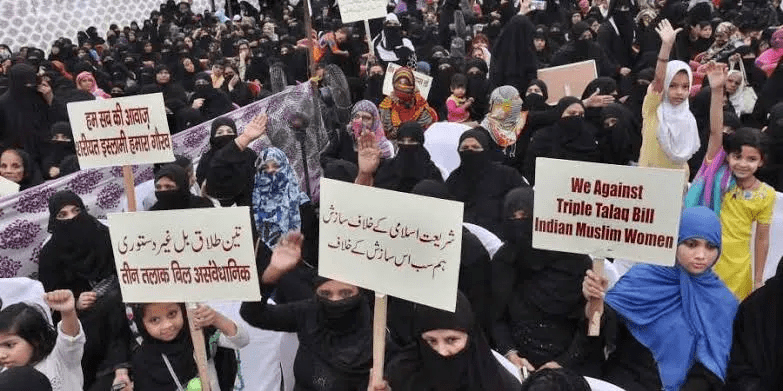
This article is written by Aaparni Jain of Maharaja Agrasen Institute of Management Studies(MAIMS),GGSIPU, an intern under Legal Vidhiya
Abstract
The judgment of the Supreme Court in Shayara Bano v. Union of India (2017) stands as a landmark verdict in India’s constitutional history. It addressed the controversial practice of Talaq-e-Biddat, commonly known as instant triple talaq, which permitted Muslim men to unilaterally divorce their wives without any formal legal process. The petitioner, Shayara Bano, approached the apex court seeking the abolition of this discriminatory practice, arguing that it violated her fundamental rights under Articles 14, 15, 21, and 25 of the Constitution. In a 3:2 majority, the Supreme Court struck down the practice as unconstitutional, thereby reaffirming the values of constitutional morality, gender equality, and judicial review over personal law. This paper explores the facts, legal issues, arguments, and impact of the case, highlighting how the decision changed the course of Muslim personal law and women’s rights in India.
Keywords
Triple Talaq, Talaq-e-Biddat, Muslim Personal Law, Article 14, Article 25, Gender Justice, Shayara Bano, Constitutional Morality, Supreme Court.
Introduction
India is a pluralistic society governed by a combination of codified laws and personal laws rooted in religion. Muslim personal law, governed by the Muslim Personal Law (Shariat) Application Act, 1937[1], allowed practices such as Talaq-e-Biddat, polygamy, and Nikah Halala, which have been a subject of constitutional challenge over the years.
The Shayara Bano v. Union of India[2] case in 2017 became a turning point in this debate. Shayara Bano, a Muslim woman from Uttarakhand, was divorced through instant triple talaq and left without financial or legal protection. She filed a writ petition under Article 32 of the Constitution seeking a declaration that the practices of Talaq-e-Biddat, Nikah Halala, and polygamy are unconstitutional.
Though the Supreme Court ultimately restricted itself to addressing only Talaq-e-Biddat, the case became a critical milestone in the interpretation of religious practices through the lens of fundamental rights. The judgment not only addressed a deeply patriarchal religious practice but also tested the limits of judicial power in regulating uncodified personal law.
Background and Context
Talaq-e-Biddat[3] is a practice in which a Muslim man pronounces “talaq” three times in one sitting, immediately and irrevocably ending the marriage. This form of divorce is not mentioned in the Quran and is generally considered sinful or irregular (biddat meaning innovation). Despite this, it was recognized under Muslim personal law in India, leading to thousands of cases where women were left abandoned without recourse.
Over 20 Muslim-majority countries, including Pakistan, Bangladesh, and Egypt, have banned the practice. In India, it persisted due to its recognition by clerics and the All India Muslim Personal Law Board (AIMPLB).
Shayara Bano’s petition brought this issue to constitutional scrutiny. She argued that the practice of instant triple talaq not only violated her dignity but was arbitrary and unilateral, depriving her of equal protection under the law. The case was heard by a five-judge Constitution Bench comprising judges of different faiths, reflecting the secular character of the judiciary.
Issues Raised Before the Court
The court considered the following key issues:
1. Whether Talaq-e-Biddat is an essential and integral practice of the Islamic religion protected under Article 25[4] of the Constitution.
2. Whether the practice violates the fundamental rights guaranteed under Articles 14[5] (Equality), 15 [6](Non-discrimination), and 21[7] (Right to Life and Personal Liberty).
3. Whether personal laws, though uncodified, can be subject to constitutional scrutiny under Part III of the Constitution.
4. Whether the practice of triple talaq is arbitrary and therefore violative of the constitutional doctrine of reasonableness and non-arbitrariness.
These questions placed the court in a position to evaluate the delicate balance between religious freedom and gender justice, and whether personal law can survive if it contradicts the basic tenets of the Constitution.
Arguments Advanced by the Petitioners
Shayara Bano and the supporting parties, including the Bharatiya Muslim Mahila Andolan (BMMA)[8], presented the following key arguments:
Violation of Fundamental Rights: The practice of instant triple talaq is inherently arbitrary, unilateral, and violates Article 14 (equality before law), Article 15 (non-discrimination on grounds of religion or sex), and Article 21 (right to life and dignity). It allows the husband to end a marriage without any reason, notice, or reconciliation, thereby treating the wife unequally.
Not an Essential Practice: The petitioners contended that Talaq-e-Biddat is not mandated by the Quran and does not form an essential religious practice under Islam. The Quran provides for reconciliation and waiting periods before divorce can be finalized. Therefore, such a practice cannot claim protection under Article 25[9] of the Constitution.
Precedents from Other Nations: It was highlighted that countries like Egypt, Jordan, Tunisia, Pakistan, and Bangladesh—despite being Islamic—have either banned or severely regulated triple talaq. If it is not an essential practice in those nations, the same must apply to Indian Muslims.
Role of the Judiciary: The petitioners emphasized that in a constitutional democracy, no personal law can override fundamental rights. Religious practices that violate constitutional values must be struck down. The courts have the power and duty to enforce fundamental rights even against religious norms.
Arguments Advanced by the Respondents
The All India Muslim Personal Law Board (AIMPLB)[10], the principal respondent, along with other Muslim organizations, defended the practice of Talaq-e-Biddat on the following grounds:
Part of Personal Law Protected under Article 25: The respondents argued that Talaq-e-Biddat has been followed for centuries by Muslims in India and is protected as an essential religious practice under Article 25 of the Constitution. They asserted that the courts must not interfere with such matters of personal faith and religious doctrine.
Judicial Non-Interference in Personal Law: It was contended that Muslim personal law has not been codified by legislation and is therefore not “law” within the meaning of Article 13, which allows the judiciary to strike down laws inconsistent with fundamental rights. Relying on the judgment in Narasu Appa Mali v. State of Bombay[11], the Board argued that personal laws cannot be tested against Part III of the Constitution.
Judicial Overreach: The Board expressed that the matter of regulating or reforming triple talaq falls within the domain of the legislature, not the judiciary. The courts should respect the separation of powers and avoid judicial legislation in matters relating to religion and customs.
Internal Reforms and Advisories: The AIMPLB claimed it had already issued advisories to Qazis to avoid using instant triple talaq and was working on internal reforms. It warned that striking down the practice might lead to unnecessary state interference in religious autonomy and community practices.
Social Structure and Religious Identity: The respondents emphasized that changes in personal laws could destabilize the community’s trust in the judiciary and challenge the secular structure, which is meant to preserve all religious practices without preference or prejudice.
The Judgment of the Supreme Court
The five-judge Constitution Bench comprised:
- Chief Justice J.S. Khehar
- Justice Kurian Joseph
- Justice R.F. Nariman
- Justice U.U. Lalit
- Justice Abdul Nazeer
The court delivered a split verdict (3:2) on August 22, 2017. The majority declared Talaq-e-Biddat unconstitutional, while the minority upheld it as valid but requested legislative intervention.
Majority Opinion (Justice Nariman, Justice Lalit, and Justice Kurian Joseph)
Justice R.F. Nariman and Justice U.U. Lalit struck down the practice by applying Article 14, stating that Talaq-e-Biddat is arbitrary, unreasonable, and violates the principle of equality.
They held that even if personal laws are not codified, they must conform to constitutional values. The Muslim Personal Law (Shariat) Application Act, 1937, was considered to be a statutory law, and hence subject to Article 13(1)[12] scrutiny. Therefore, any practice supported by this Act can be tested for constitutional validity.
Justice Kurian Joseph, in a separate but concurring judgment, observed that Talaq-e-Biddat is not in conformity with the Quran. Since the Holy Quran does not approve of instant divorce, the practice cannot be considered an essential religious practice under Islam.
He stated: “What is bad in theology is bad in law.”
All three judges ruled that the practice is void and unconstitutional as it violates fundamental rights.
Minority Opinion (Chief Justice Khehar and Justice Abdul Nazeer)
Chief Justice J.S. Khehar and Justice Abdul Nazeer dissented. They held that Talaq-e-Biddat is indeed a part of the religious belief and is protected under Article 25.
They emphasized that courts should not interfere in matters of religious doctrine, especially where the practice is deeply rooted and has scriptural legitimacy, even if it’s undesirable.
However, they suggested that Parliament should bring a law to regulate triple talaq and stayed the operation of triple talaq for six months to allow for legislative action.
Their opinion reflected judicial restraint, showing deference to religious autonomy and legislative competence.
Constitutional and Legal Principles Applied
The majority judgment rested on several crucial constitutional doctrines and principles:
Article 14 – Right to Equality: The judges emphasized that Talaq-e-Biddat is arbitrary because it gives unilateral power to the husband with no opportunity for reconciliation or judicial oversight, which goes against the constitutional guarantee of equality before the law.
Article 25 – Freedom of Religion: The court clarified that religious freedom is not absolute. Only essential religious practices are protected. Since triple talaq is not essential to Islam and is denounced in several Islamic countries, it cannot claim protection under Article 25.
Doctrine of Arbitrariness: Borrowing from Maneka Gandhi v. Union of India[13] and EP Royappa v. State of Tamil Nadu[14], the court applied the principle that arbitrary laws are inherently unequal and unconstitutional.
Article 13(1): It was held that even personal laws derived from statutes (like the 1937 Shariat Act) can be tested against fundamental rights under Article 13(1), thus rejecting the Narasu Appa Mali precedent in this context.
Critical Analysis
The Shayara Bano judgment is a landmark in the evolving narrative of gender justice in India. It is an example of how the Supreme Court has moved beyond the traditional understanding of personal law and embraced the supremacy of constitutional rights.
The majority judgment rightly prioritized individual dignity over archaic practices rooted in patriarchal traditions. By using the arbitrariness doctrine under Article 14, the Court reaffirmed its position that equality is the foundation of all laws—whether secular or religious.
One of the most significant contributions of the judgment is its clarification of the “essential religious practices” test. The bench noted that not every religious practice deserves constitutional protection—only those integral and indispensable to the religion. Since Talaq-e-Biddat was neither essential nor even Quranically justified, it could be discarded as unconstitutional.
The judgment also reflected the plural and secular ethos of India by constituting a bench of judges from different religious backgrounds, showing that the judiciary is not biased toward or against any faith.
The Shayara Bano judgment demonstrates the evolving role of the Indian judiciary in upholding constitutional values, even when they intersect with personal religious laws. The verdict moves India a step closer to substantive equality, particularly for women of marginalized religious communities.
The decision drew praise from women’s rights activists, constitutional scholars, and civil society for its progressive tone and focus on constitutional morality. The Court acknowledged that constitutional values such as equality, dignity, and liberty are non-negotiable and override any social or religious practice that contravenes these values.
However, the judgment also highlighted tensions within the legal system. The split verdict showed that the judiciary remains divided on how far it can or should intervene in religious matters. While the majority took a bold stand, the minority warned against judicial overreach, emphasizing that reforms should ideally come through the legislature.
Another limitation of the judgment is its narrow scope—the Court only ruled on Talaq-e-Biddat, leaving other related practices like polygamy and Nikah Halala untouched. These practices, too, raise serious concerns under Articles 14 and 21 and need urgent judicial and legislative scrutiny.
Legislative Impact – Muslim Women (Protection of Rights on Marriage) Act, 2019
The Shayara Bano judgment paved the way for legislative action. In 2019, the Indian Parliament enacted the Muslim Women (Protection of Rights on Marriage) Act[15], which formally criminalized the practice of instant triple talaq.
Key features of the 2019 Act include:
- Declares instant triple talaq void and illegal.
- Makes the act of pronouncing talaq a cognizable offence, punishable by up to three years’ imprisonment and a fine.
- Provides for the right of maintenance to the wife and custody of minor children, as determined by a magistrate.
- Allows only the wife (or a blood relative) to file a complaint under the Act.
The Act was passed amidst strong debate. Supporters praised it as a necessary step toward gender justice, while critics argued that criminalizing a civil matter could lead to misuse and further victimization of Muslim men.
Nonetheless, the 2019 Act gave the Shayara Bano judgment statutory backing, thereby making it enforceable and effective at the ground level.
Social and Constitutional Implications
The verdict has far-reaching implications for Indian society and constitutional jurisprudence:
Empowerment of Muslim Women: The ruling was a significant victory for Muslim women, who had long suffered under arbitrary and patriarchal divorce practices. It sent a message that the Constitution will protect all women equally, regardless of religion.
Strengthening Secularism: By striking down a religious practice that violated fundamental rights, the Court upheld the secular character of the Constitution—where laws and justice are not dictated by religion but by equality and fairness.
Essential Religious Practices Doctrine: The case clarified the use of the essential practices test, stating that only those practices integral to a religion deserve constitutional protection. It created a precedent for future reforms in other religions as well.
Judicial Activism vs. Restraint: The case sparked a debate on judicial activism. While some viewed the majority opinion as progressive, others saw it as a breach of religious autonomy. The dissenting judgment underscored the need for a cautious and balanced approach by the judiciary.
Need for Uniform Civil Code (UCC): The judgment rekindled the conversation around Article 44[16] of the Constitution, which calls for a Uniform Civil Code. Many believe that uniformity in personal laws is the only way to ensure gender equality and legal consistency across communities.
Conclusion
The Shayara Bano judgment is a watershed moment in India’s constitutional history. It reflects the transformative potential of the judiciary to reinterpret personal laws in accordance with the Constitution. The verdict goes beyond the issue of triple talaq—it is a powerful statement that religious customs must evolve when they conflict with fundamental rights.
The case showcased the ability of the Indian judiciary to protect the dignity and rights of marginalized individuals, particularly women. Though the judgment is limited to Talaq-e-Biddat, it has opened doors for further reforms and laid down a clear message: the Constitution is supreme, and personal laws must conform to its ideals.
India still has a long way to go in reforming all personal laws. But this judgment provides a strong foundation and a template for future legal and social reforms in the direction of justice, equality, and human dignity.
References
- Shayara Bano v. Union of India, (2017) 9 SCC 1.
- The Constitution of India, 1950.
- Muslim Women (Protection of Rights on Marriage) Act, 2019.
- Mohd. Ahmed Khan v. Shah Bano Begum, (1985) 2 SCC 556.
- Daniel Latifi v. Union of India, (2001) 7 SCC 740.
- Maneka Gandhi v. Union of India, (1978) 1 SCC 248.
- EP Royappa v. State of Tamil Nadu, (1974) 4 SCC 3.
- State of Bombay v. Narasu Appa Mali, AIR 1952 Bom 84.
- Law Commission of India, “Consultation Paper on Reform of Family Law”, August 2018.
- Tahir Mahmood, Muslim Law in India and Abroad, LexisNexis (2012).
- Flavia Agnes, “Interrogating Muslim Women’s Rights,” Economic and Political Weekly, Vol. 50, No. 33 (2015)
- Faizan Mustafa, “Triple Talaq and the Law,” The Hindu, August 23, 2017.
[1] The Muslim Personal Law (Shariat) Application Act, No. 26 of 1937, INDIA CODE (1937).
[2] Shayara Bano v. Union of India, (2017) 9 SCC 1.
[3] aizan Mustafa, Triple Talaq and the Law, The Hindu (Aug. 23, 2017), https://www.thehindu.com/opinion/lead/triple-talaq-and-the-law/article19540989.ece.
[4] India Const. art. 25.
[5] India Const. art. 14.
[6] India Const. art. 15.
[7] India Const. art. 21.
[8] Bharatiya Muslim Mahila Andolan, Indian Muslim Women’s Movement: For Gender Justice and Equal Citizenship (Zubaan 2016).
[9] India Const. art. 25.
[10] All India Muslim Personal Law Board, www.aimplboard.in (last visited July 8, 2025).
[11] State of Bombay v. Narasu Appa Mali, AIR 1952 Bom. 84 (India).
[12] INDIA CONST. art. 13, cl. 1.
[13] Maneka Gandhi v. Union of India, (1978) 1 SCC 248 (India).
[14] E.P. Royappa v. State of Tamil Nadu, (1974) 4 SCC 3 (India).
[15] The Muslim Women (Protection of Rights on Marriage) Act, No. 20 of 2019, § 3, India Code (2019).
[16] India Const. art. 44.
Disclaimer: The materials provided herein are intended solely for informational purposes. Accessing or using the site or the materials does not establish an attorney-client relationship. The information presented on this site is not to be construed as legal or professional advice, and it should not be relied upon for such purposes or used as a substitute for advice from a licensed attorney in your state. Additionally, the viewpoint presented by the author is personal.




0 Comments